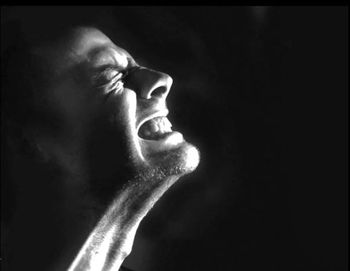
Pectoralis Major Partial Tear
A 36-year-old man presented with persistent right shoulder weakness and pain (4 out of 10 on the visual analog scale). He also had an “odd pulling sensation” with arm adduction. During a wrestling match 2 years earlier, his arm was abducted and extended, after which he heard a popping noise and felt burning pain in his shoulder.
A 36-year-old man presented with persistent right shoulder weakness and pain (4 out of 10 on the visual analog scale). He also had an “odd pulling sensation” with arm adduction. During a wrestling match 2 years earlier, his arm was abducted and extended, after which he heard a popping noise and felt burning pain in his shoulder. This was followed by localized swelling with noticeable arm weakness, particularly when he pulled something heavy toward him using the injured arm. Plain films and MRI scans were interpreted as normal, and he was treated conservatively for an unspecified muscle strain.
Examination revealed a palpable nontender knot in the anterior chest within the axillary fold. The patient had a noticeable 2-inch indentation at the deltopectoral groove that extended medially on maximal muscle contraction of the right pectoralis major (A). He had full range of motion with subtle weakness and delay of right arm adduction when compared with the left. Strength on internal rotation, flexion, and extension of the right arm was comparable to that of the left arm. Sensation and reflexes were intact and symmetrical.
Axial T1-weighted imaging revealed a partial tear of the pectoralis major at the myotendinous junction that primarily involved the clavicular head of the muscle (B, white arrow). The conjoint tendon at the humeral insertion site was intact (B, yellow arrow); tissue edema and hemorrhage were absent. Coronal T1-weighted imaging showed evidence of fat infiltration in the area of the defect (C and D, arrows).
Pectoralis major tears are relatively rare. The most common mechanism of injury is weight lifting, specifically bench-pressing.1 The arm is abducted, externally rotated, and extended at the shoulder, during which maximal eccentric muscle contraction can cause partial or complete pectoralis major tears either proximally at the sternal, clavicular, and chest wall origins or distally at the musculotendinous junction and tendinous insertion site near the humerus.2-4
Pectoralis major tears may present similarly to muscle strains and rotator cuff injuries. A high index of suspicion along with a comprehensive history and physical examination are needed to differentiate these injuries. A key finding in patients with pectoralis major tears is weakness with arm adduction, internal rotation and, to a lesser extent, forward flexion.4
In the acute setting of a pectoralis major tear, swelling and bruising can obscure the visibility of an anterior wall defect. Plain films are usually normal. MRI reveals localized fluid collection, edema, hemorrhage, and inflammation.5 The patient may need to be reevaluated at a later time after the swelling and pain have subsided. In the chronic setting, persistence of an anterior chest wall defect or loss of normal contour of the axillary fold may be noted without ecchymosis or swelling. MRI may show fat infiltration, muscle atrophy, and retraction, without fluid collection or hemorrhage.5
Early diagnosis and classification of the injury help determine whether conservative treatment or surgery is appropriate. Outcomes may depend on the timing of surgery. Although some studies have shown more rapid return to previous function and strength and better cosmesis and overall patient satisfaction with surgical repair of acute pectoralis major tears, excellent outcomes have been reported regardless of the timing of surgery.1 It is difficult to say whether this patient may have benefited from surgery if the tear had been diagnosed shortly after the injury occurred.
This patient had a high-grade (involving more than 50% of the muscle) partial pectoralis major tear; in his case about 75% of the muscle was involved. He was referred to an orthopedist for further evaluation. He ultimately decided to continue with conservative treatment.
References:
REFERENCES:
1.
Zvijac JE, Schurhoff MR, Hechtman KS, Uribe JW. Pectoralis major tears: correlation of magnetic resonance imaging and treatment strategies.
Am J Sports Med.
2006;34:289-294.
2.
Dodds SD, Wolfe SW. Injuries to the pectoralis major.
Sports Med.
2002;32: 945-952.
3.
McEntire JE, Hess WE, Coleman SS. Rupture of the pectoralis major muscle: a report of eleven and review of fifty-six.
J Bone Joint Surg Am.
1972;54:1040-1046.
4.
Wolfe SW, Wickiewicz TL, Cavanaugh JT. Ruptures of the pectoralis major muscle: an anatomic and clinical analysis.
Am J Sports Med.
1992;20:587-593.
5.
Carrino JA, Chandnanni VP, Mitchell DB, et al. Pectoralis major muscle and tendon tears: diagnosis and grading using magnetic resonance imaging.
Skeletal Radiol.
2000;29:305-313.
DISCLAIMER
The views expressed here are those of the authors and do not reflect the official policy or position of the Department of the Army, Department of Defense, or the US Government.
Newsletter
Enhance your clinical practice with the Patient Care newsletter, offering the latest evidence-based guidelines, diagnostic insights, and treatment strategies for primary care physicians.



















































































































































































































































































